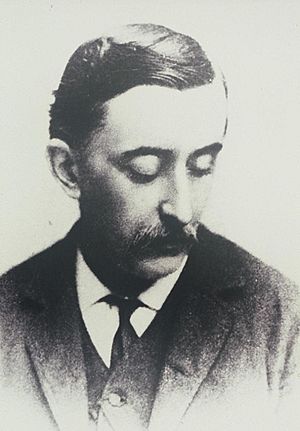Japanophilia facts for kids

Japanophilia is when someone has a strong interest in Japanese culture, people, and history. It's like being a big fan of Japan! In Japanese, this feeling is called "shinnichi" (親日). The word "shin (親)" means 'pro-' or 'in favor of', and "nichi (日)" means 'Japan'. So, "shinnichi" means 'pro-Japan'. People have been interested in Japan for a long time, even centuries ago. The opposite of Japanophilia is Japanophobia, which means disliking Japan.
Contents
Early Interest in Japan
The idea of being a "Japanophile" started way back in the late 1700s and early 1800s. This was before Japan fully opened up to other countries for trade. People like Carl Peter Thunberg and Philipp Franz von Siebold helped introduce Japanese plants, artworks, and other cool items to Europe. This sparked a lot of interest in Japan.
Lafcadio Hearn, an Irish-Greek writer, moved to Japan in the 1800s. He was known for his deep love for Japan. The Charles E. Tuttle Company even called him "a confirmed Japanophile" in his books. Another famous example is Jules Brunet, a French Army officer who played a role in Japan's Boshin War.
Japan's Influence in the 20th Century
In the early 1900s, some British writers really admired Japan. For example, in 1904, Beatrice Webb wrote that Japan was a "rising star." She praised the Japanese people for their self-control and new ways of thinking. She also admired their smart and open-minded leaders.
Another writer, H. G. Wells, even named the special leaders in his book A Modern Utopia "samurai." This interest grew partly because Britain's own industries were slowing down, while Japan and Germany were growing fast. Germany was seen as a rival, but Japan was seen as a possible friend. Many in Britain looked to Japan for ideas on how to be more efficient. However, this strong interest faded after World War I.
The Samurai Code
General José Millán-Astray, who started the Spanish Legion, was greatly influenced by the samurai warrior code called Bushido. He called Bushido "a perfect creed." Millán-Astray believed that Spanish soldiers were like samurai. He said they followed the main ideas of Bushido: Honor, Valor, Loyalty, Generosity, and Sacrifice. He even translated Inazo Nitobe's book Bushido: The Soul of Japan into Spanish.
Japan's Popular Culture Today
In the early 2000s, some new words appeared to describe people who were very interested in Japanese popular culture. One term was "wapanese," which came from "white Japanese" or "wannabe Japanese." This word was used for non-Japanese people, especially white people, who were obsessed with Japanese culture. This included things like anime, manga, and visual novels.
Another term that became popular was "weeaboo" (sometimes shortened to "weeb"). This word first came from a webcomic. Later, it was used on a website called 4chan to replace "wapanese." While these words were first used to be mean, some fans of Japanese media now use them for themselves in a funny or self-mocking way.
Justin Sevakis, a writer for Anime News Network, explained the difference between a "weeaboo" and someone who just enjoys Japanese culture. He said it's great to love Japanese culture. But a person might be called a "weeaboo" if they act annoying, childish, or don't really understand the culture they claim to love. Matt Jardin from the Alaska Dispatch added that "weeaboos" might blindly prefer things from Japan while looking down on everything else, even if it's good.
See Also
 In Spanish: Japonofilia para niños
In Spanish: Japonofilia para niños
- Japanization
- Japanification
- Japonisme
- Orientalism
- List of Westerners who visited Japan before 1868
- Japanese studies
- Cool Japan
- Japan Expo
- Anime club
- Pacific Movement of the Eastern World
- Sinophile
- Jingri

